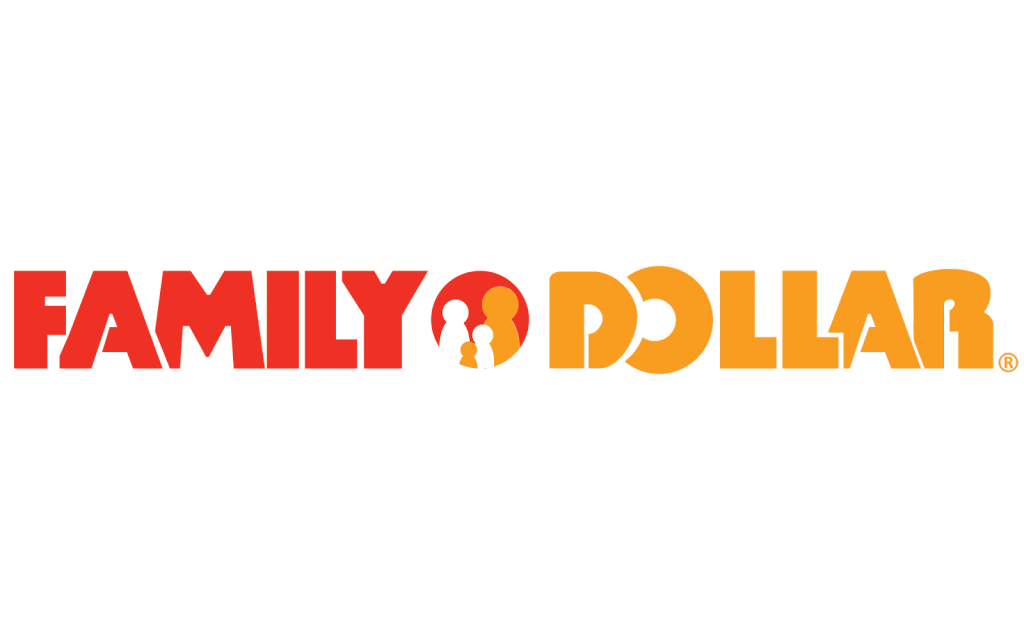
Family Dollar is a company that runs retail discount stores that offer a variety of goods. They range from selling clothing, household goods, and grocery items in their stores. The story of both their logo and their company starts at the bottom and rises with a company that now proudly operates over 8,000 stores that are in 44 states.
Family Dollar may be one of the most universally recognized logos that has been kept clean and simple since the start. Family Dollar was founded in 1959 and since then has developed a logo that is iconic and simple, being an example to those of how a powerful logo can be simple yet strong and memorable. Over time the logo has undergone a variety of changes, adapting to more modern looks and changing in style until it’s become the legendary logo that we know it as today.
Starting with a minimalist and non-descriptive version for the first logo, it’s now developed into a strong logo that displays the company and what they do.
Let’s take a deep dive into the history of the Family Dollar logo, the company, and where they’re at now.
1950s – 1960s: The Very First Logo
inscription with two different levels. Enclosed in a rectangle on the first level there was shown “Family Dollar” while in a second rectangle below the first there was “Store” written. This was a strong and professional logo that stood out and had its own identity.
The logo lasted ten years with the company before they decided that it was due for a change. The logo took a change, the option for cartoonish fun lettering in the same black and white that the first logo had. The first two words were in a cartoon, chunky font, and overlapped while the bottom half of the words were in a traditional font and were evenly spaced.
1974 – 2005: Color Is Introduced
1974 marked a time where a new design was introduced and the company decided to bring in some color to what had been black and white before. Although this was a new design, Family Dollar made sure that they kept a logo that could still be easily and instantly recognized by customers. The overlapping letters from the earlier logo were now straight and white with a red outline. The word ‘Store’ was removed from the logo, creating a logo that was more straightforward than the first.
2005 – Present: Today’s Logo
After quite a few changes throughout the years, the company finally settled on today’s logo to be kept as the company’s symbol. They kept the same name and lettering but instead decided to change the palette. They opted to add a new shade, orange, to the design. In addition to this change, the logo changed from merely a wordmark to include a design in between the letters as well. The wordmark was separated by a red circle, with an abstract image of a family inside of it. This gives the logo a new meaning and adds emphasis to it, giving the stores a warm and inviting feel.
The History Of Family Dollar
Family Dollar proudly boasts that they have over 8,000 store locations, in almost all U.S states. Family Dollar was bought in 2015 by Dollar Tree and has become one of the most largely recognized stores around the country. The same as their iconic logo the company also started small and then developed to something stronger and bolder throughout time.
Family Dollar was founded in 1959 by Leon Levine. The Levine family came from a long line of experienced entrepreneurs and Leon Levine was fascinated with the idea of starting a budget self-service retail store. In 1958 the young entrepreneur, only 21 at the time, was engaged with merchandising and truly believed that it was possible to have a store where customers could purchase quality goods for less than $2.
The first Family Dollar was opened in 1959 in Charlotte and it was the first step towards it becoming one of the largest and greatest retail chains in the world. Levine had a simple yet effective goal for Family Dollar; he wanted it to be a retail store where customers enjoyed being and where they had the ultimate decision making. The floor plan of the stores followed this philosophy, allowing customers to easily access their favorite items at the store.
With the budget-friendly pricing and the ease of walking in, grabbing what you needed from the shelves nad paying cash, it’s no wonder that the store became as popular as rapidly as it did. At the time, having a store that wasn’t only easy but also had low cash pricing for customers was important. However, Family Dollar didn’t always have good times for their store and they didn’t always have a clear and bright future ahead of them.
Family Dollar Had Struggles
From their first store in 1959 well into the 1960s, Family Dollar experienced strong and rapid success. They were quickly opening more stores and expanding into the southern states throughout the decade. By the end of the decade, Family Dollar had 27 stores in four states and they had annual sales of more than 5 million. They were rising quicker than anyone, even Levine himself could have anticipated, and were headed towards rapid success.
However, that doesn’t mean that the company didn’t have its fair share of hardships and issues that came with its success over the years. Although by end of the decade Family Dollar had launched its 200th location and its first Charlotte distribution location, the 1970s ended up being a difficult period for the young variety store chain. By the mid-1970s Family Dollar saw difficulties that were mainly due to the U.S. textile industry which mainly impacted the company’s customers in the southeast.
As employees in the industry were let go Family Dollar started to struggle as their sales declined. Between 1974 and 1975 the company saw massive declines that certainly put their sales on a roller coaster of sales, but that didn’t mean that they gave up. Instead, the company continued, assembling a new marketing team and deciding to break from their idea of selling items for under $3.
As things started to stabilize and return to normal within the market Family Dollar started to come out the other side and do better. This shows that, although they had difficulties as any company does, they managed to make the most out of it. They survived their most difficult years and continued even during the hard times.
The Rest Of Their Years
After what had seemed to be a tough decade for the company and in 1981 they opened their 400th store. From 1982 to 1987 they opened 100 stores but towards the end of the decade, they experienced competition from Walmart slashing prices. This may have set them back ways in their record sales but the company was quick to slash their prices in retaliation. In 1987 Ralph Dilon became the new CEO of the company and decided that he would slash prices even further and also included higher-end merchandise in the store.
In the 1990s Family Dollar had expanded even further and had become a neighborhood convenience store model that was popular with families. By the 2000s they had more name-brand items in their store and they had exceeded $3 billion in sales. They made the Fortune 500 list by 2002 and were steadily growing.
Now they’re still a strong chain and one that you’ll typically find in small towns and they sell products for less than what you’ll find in the larger retail stores. Although the majority of products are now priced higher than $1, the vast majority are less than $10. Family Dollar has turned into a budget-friendly company that allows families to shop for high-quality products that are located in neighborhoods all around the country.
About Leon Levine
Without Leon Levine Family Dollar wouldn’t exist and it certainly wouldn’t be as strong of an empire as we know it today. Leon is the reason that Family Dollar grew so rapidly and was the driving force behind it and his thoughts and techniques were what grew it into such a large chain. Leon was born in 1937 in Rockingham. At the time his father ran a five-and-dime department store called The Hub, where shoes and clothing were sold to customers.
Leon’s mother took over running the shop when his father died when Leon was only twelve. Leon stepped up with helping his mother with work, beginning to work weekends, and learned by watching his older brother working in the shop. Years later when Leon turned 16 his mother began to take more breaks, leaving Leon to run the store while she was gone and to supervise the store’s 18 employees.
A year later and Leon had learned more and he asked his mother if he could open his own bargain basement where he lowered the pricing on what wouldn’t sell. This was the start of Leon not only learning the business and how to sell but also understanding that the right pricing would convince anyone to buy. Over the next few years, Leon married, learned about factories and bought a stake in Union Craft Company in Wingate. At 22 he opened his first Family Dollar and although not everything was $1, a few things were as cheap as a few dimes.
Leon wanted to focus on making sure that nothing he sold was cheap material but it was still affordable for customers. Soon one became four Family Dollars and he started building the empire. Leon continued to be involved with all decisions of Family Dollar and was key to making it as successful as we know it today.
Summing Up The History Of The Family Dollar
Family Dollar has products for home and family needs located in 44 states and has grown more and more popular since it first began. The first Family Dollar was launched in 1959 by Leon Levine and has since then grown around the country. Their stores are located mainly in the Southwestern, Northwestern, Northeastern, and Southeastern regions with over 8,000 locations. They have annual sales of $4.75 billion and are continually growing and expanding their company.
If there’s one thing that we know for certain it’s that the logo is an attribute of the company that has made the biggest impact. When it comes to companies, their visual identity is what plays a critical part in not only branding but building a relationship with customers. It’s how they recognize the company and know the brand, even from miles away. Family Dollar has worked to build relationships and create a business that is centered on its customers and what they need.
They’ve created a business that allows families to purchase high-quality goods at budget pricing and an environment where they can find what they need. When creating this company all areas of the business needed to reflect exactly that, including the visual identity. They needed their branding to be strong and reflect their values and products. After going through a series of changes until they found exactly what they were looking for, the company finally had the perfect logo for their business and exactly what they needed.







